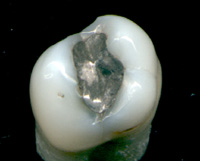
Photo from wikipedia
Among the pillars of sustainability in health care units is environmental protection. Although an EU-wide dental amalgam phase-out legislation exists, quantities of this material are still to be found in… Click to show full abstract
Among the pillars of sustainability in health care units is environmental protection. Although an EU-wide dental amalgam phase-out legislation exists, quantities of this material are still to be found in the market, dental offices or in the mouths of patients. The purpose of this study is to record the views of dentists and dental students in Greece regarding the use and safety of dental amalgam for people and the environment as well as their attitudes towards its restriction and disposal. Materials and methods: Two different questionnaires, through Google forms, were filled by each group. Descriptive statistics were used to describe the variables. The chi-square test or the chi-square test with Yates correction was used to examine potential differences per group (p-value = 0.05). Overall, 564 people participated in this study; 462 (81.9%) dentists (N1) and 102 (18.1%) dental students (N2). Results: Both groups agreed that they no longer use dental amalgam often. Dentists (39.8%) and students (36.4%) consider amalgam to have a moderate burden on the environment. This answer differed significantly per year of profession and year of undergraduate studies, respectively, with dentists from 6–25 years in the profession and 4th-year students, being the least aware on the environmental footprint of dental amalgam. Further, professionals (70%) and students (60%) believe that dental amalgam has a hazardous impact on patient’s health, at all or to a small extent. For staff health, dentists reported at a moderate degree dangerous impact (32.9%) while students (36.4%), respectively. The impact on patients and staff health, were found to differ significantly per region of practicing dentistry for both groups. Finally, there were suggestions made from both groups about the necessity of information sharing on amalgam and mercury safety and the impact on the environment at the level of professional organizations. Conclusions: Students, younger dentists and those living in non-urban regions seem to be more sensitive to the environmental impact of amalgam use, disposal, and health of people. Environmental issues should be addressed thoroughly by professional organizations, enhancing relevant activities for all people involved.
Journal Title: Dentistry Journal
Year Published: 2023
Link to full text (if available)
Share on Social Media: Sign Up to like & get
recommendations!